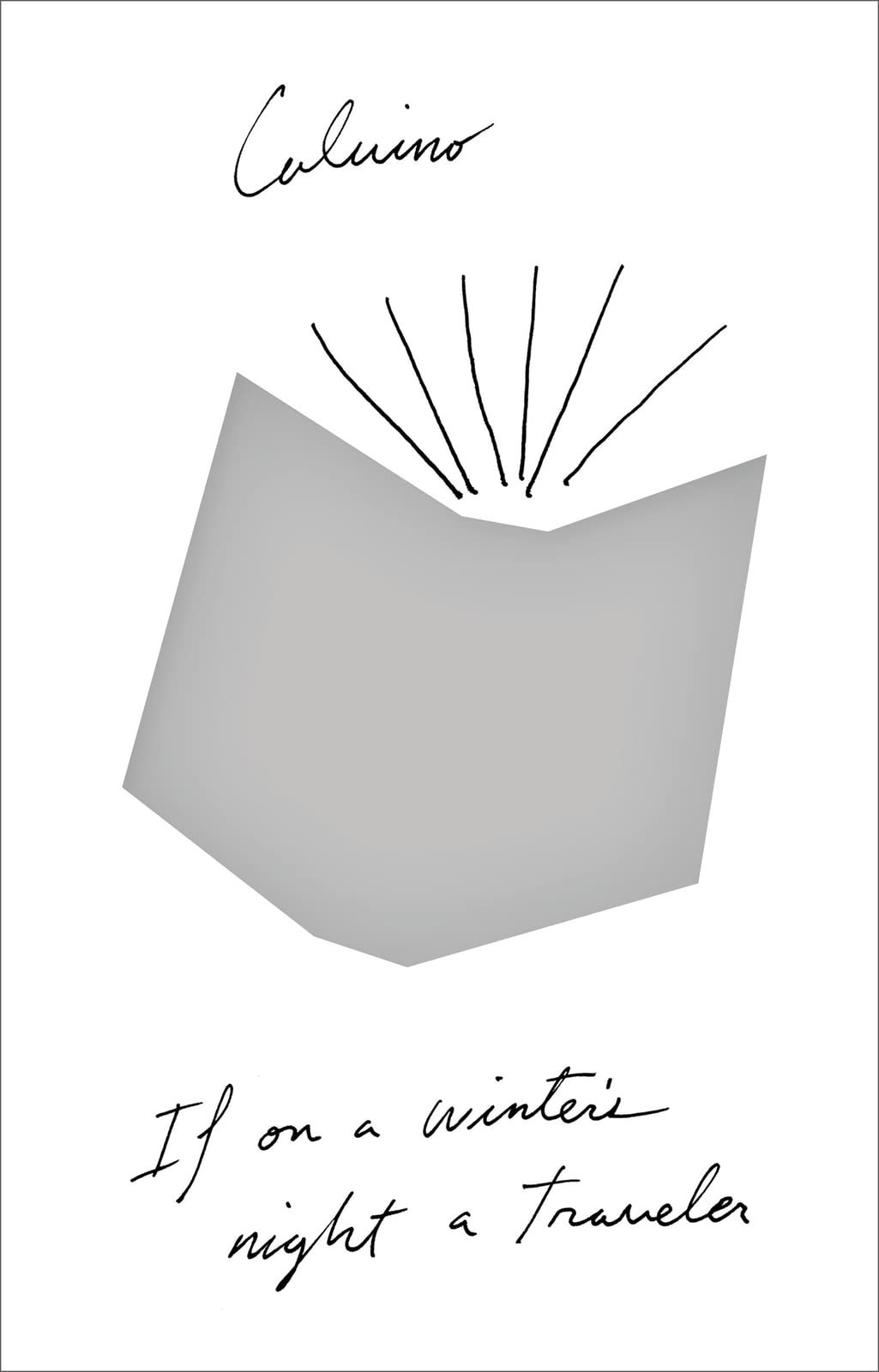Book Of The Month: If On A Winter's Night A Traveler
This page may contain affiliate links. As an Amazon and Rewardstyle affiliate, we may earn a small commission for any purchases made through these links. Click here for the disclosure statement.
Imagine that you are reading a novel and within that novel, the main character of the novel is reading the same novel that you are.
What? It’s fine if you have to re-read that sentence.
Now, imagine in this novel that you are reading, that there are ten separate, completely unrelated novels that begin and end with only a first chapter. A story begins, catches your interest, and then right at the moment of resolution or climax, the chapter ends, disappears without a trace, and switches to the first chapter of an entirely different novel with a different setting, characters, and time.
This happens ten times.
Frustrating, right? The protagonist of the novel that you are reading—or the Reader, as he is called—is also frustrated along with you.
If on a winter's night a traveler
Originally Published: 1979
Pages: 260
Available on: Kindle, Paperback, Hardcover, Audiobook
GET YOUR COPY HERE
“ “Reading is going toward something that is about to be, and no one yet knows what it will be.” ”
Now imagine the author directly addressing you, sympathizing with your confusion, but barreling along merrily without pause, bouncing from story to story, while you and the Reader (Or, are you the same?) keep trying to pick up the pieces and shout for clarity and track down the original story because…goddamnit, you're just trying to read the book, not go around a revolving door!
““The difference between the true and the false is only a prejudice of ours.””
From the first magnetizing and affronting sentence, “You are about to begin reading Italo Calvino's new novel, If on a winter's night a traveler. Relax. Let the world around you fade.“ Italo Calvino snatches readers attention and makes it clear that If on a winter's night a traveler is no ordinary novel and that he pays no dues to traditional structure in literature. Honestly, he treats it as Play-Doh.
If on a winter's night a traveler can easily be compared to the Matrix or a double mirror. Structurally, there are 12 chapters. The first ten chapters have two parts.
The first part of each chapter contains a protagonist, the Reader, a young man and book enthusiast, who is experiencing a great deal of frustration as he tries to read a novel. Ten times he starts a book, only for it to be cut off by a completely different story, after only the first, intriguing chapter. Is it a misprint? A bad translation? A publishing error? In his search, he meets an attractive young woman, another book enthusiast, who is also affronted by the ever-changing novel, and he goes on a variety of spontaneous, thwarted adventures to get to the bottom of this questionable novel (and win the girl, as well).
The second part is the ever-changing story that this protagonist has read. These stories are dark, ironic, and sadistic, and start whimsically and suddenly in a mysterious and foreign setting. All of them are a little maddening.
One story is about a man who is trying to extract the name of his unknown mother from his dying father, at the final moments of his father’s life. (He doesn’t get the name. No surprise, thanks, Calvino.) Another story is about two writers who sit opposite one another in their separate apartments, spying on the other’s writing tactics and patterns, envious and brooding and critical of the other. One is productive and successful, (but rather mainstream) while the other is unsuccessful and undergoing writer’s block, but capable of “deeper” writing; yet both writers are disdainful towards and jealous of the other. Again and again, Calvino sets up ironic and amusing scenarios that are out of balance and spun purely from imagination.
Alternating between a new story and the Reader’s experience of reading and attempting to find the rest of each story, the novel unfolds like a Slinky toy, bouncing down a winding staircase.
““I felt a kind of vertigo, as if I were merely plunging from one world to another, and in each I arrived shortly after the end of the world had taken place.” ”
In this way, we are experiencing the same, parallel bewilderment that the protagonist does. It is a playfully genius and experimental effort on the author’s part to engage and challenge readers in very unique ways. If on a winter's night a traveler is a book about books, a book about the act and intention and purpose of reading.
““I’m producing too many stories at once because what I want is for you to feel, around the story, a saturation of other stories that I could tell and maybe will tell or who knows may already have told on some other occasion, a space full of stories that perhaps is simply my lifetime, where you can move in all directions, as in space, always finding stories that cannot be told until other stories are told first, and so, setting out from any moment or place, you encounter always the same density of material to be told.””
This book is really a delight, and you cannot get away from the feeling that Calvino just had a ball writing this book. It is scattered, but intimate. The mischievous, playful tone is light and teasing, and the novel turns out to be a glorious collection of happenings and meaningful coincidences that require a reader’s close concentration and connections. Calvino stretches our understanding of reading and writing, challenges accepted and linear notions of plot and literary style, and teases readers not to take understanding so seriously.
For example, each of the novels begin with discombobulated phrases such as “If on a winter’s night…,” “Outside the town of Malbork..,`` “Leaning from the steep slope”. At the end of the novel, Calvino strings each of these separate phrases together, and they form one long, chilling sentence that resonates with the journey that the Reader has undertaken in his search for the novels.
““If on a winter’s night a traveler, outside the town of Malbork, leaning from the steep slope without fear of wind or vertigo, looks down in the gathering shadow in a network of lines that enlace, in a network of lines that intersect, on the carpet of leaves illuminated by the moon around an empty grave—What story down there awaits its end? he asks, anxious to hear the story.””
This correlates with the conclusion that the Reader comes to as well. The Reader, so anxious to know the end, has been blocked again and again by beginnings, by new stories, do-overs, un-resolutions. He is dying for a conclusion, and is affronted when he comes to the realization that conclusion would be…death, in a way. As Calvino said:
“Do you believe that every story must have a beginning and an end? In ancient times a story could end only in two ways: having passed all the tests, the hero and the heroine married, or else they died. The ultimate meaning to which all stories refer has two faces: the continuity of life, the inevitability of death.”
So the Reader can either choose life or death, and by the end of the book, he seems to choose to trust the natural process of not knowing how a story will go, or how his own life will unfold. It seems that Calvino spends much of the novel showing all readers (the Reader and us, the readers) that stories and lives are non-linear; that we should stop trying to control or understand exactly what, why, and how a story unfolds, real or not.
Calvino also plays with the idea of what it is to be a writer and plays with the relationship between author and reader, posing ironic situations and asking questions directly to the reader. How do people read? Why do different readers interpret texts differently; why do words and ideas mean different things to different minds? How can one be a writer? Where do his ideas form; why can’t one perfect the art of writing?
If on a winter's night a traveler was written by Italo Calvino, a writer and journalist, originally in Italian and published in 1979. A postmodernist narrative, the book continues to baffle, amuse, enrage, and challenge readers to this day.
I would recommend this book if you want to challenge your reading level, need a refresher if you’ve been reading too much of one genre, enjoy experimental literature, and like your mind being bent in half by a good book.
One final great quote that aptly captures the essence of this entirely batty, incredible book:
““The book I’m looking for,’ says the blurred figure, who holds out a volume similar to yours, ‘is the one that gives the sense of the world after the end of the world, the sense that the world is the end of everything that there is in the world, that the only thing there is in the world is the end of the world.” ”




